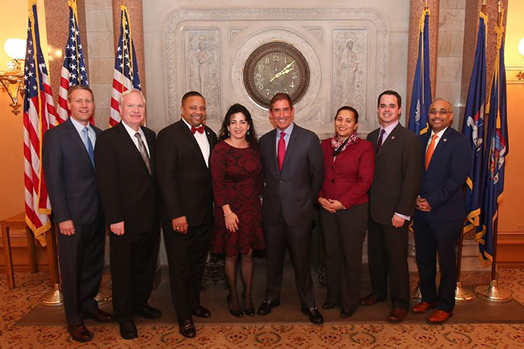Allegro
A Lesson in Politics, Power and Influence in Albany
The Independent Democratic Conference
Volume 117, No. 3March, 2017

Christopher Carroll
On Jan. 25, political circles, advocacy groups and elected officials were shaken by the news that Queens State Senator Jose Peralta had joined the Independent Democratic Conference, a breakaway group of Senate Democrats who currently caucus with Republicans and have tipped the balance of power from Democrats to Republicans in that legislative body.
While Peralta’s addition brings the IDC’s ranks to eight and strengthens the IDC’s influence in Albany, it has also brought new and increased public scrutiny to this breakaway group of state senators, as well as to the role they play in our democratic process.
From the Daily News and New York Times, to overflowing and angry town hall meetings, the IDC’s role in Albany, a topic that previously had been confined to government insiders, lobbyists, journalists and policy wonks, is suddenly receiving attention from the general public. Why? People are realizing that local elections, and local policy, matter. This is a good thing for the state and for democracy in this country. Americans must prioritize local elections.

The Independent Democratic Conference (left to right): Senator David J. Valesky (District 53, Syracuse), Senator Tony Avella (District 11, Queens), Senator Jessie Hamilton (District 20, Brooklyn), Senator Diane Savino (District 23, Staten Island & Brighton Beach), IDC Leader Jeffrey Klein (District 34, Bronx), Senator Marisol Alcantara (District 31, Manhattan), Senator David Carlucci (District 38, Rockland & Westchester counties), Senator Jose Peralta (District 13, Queens).
THE POLITICAL LANDSCAPE
Following President Trump’s election in November, Democrats, progressives and liberal voters across the country are finding themselves forced to acknowledge the ramifications of the fact that their party has failed to hold leadership positions in local and state government.
Years of focusing on the top of the ticket have taken a massive toll on the vibrancy and relevancy of the party nationally. Today, Democrats control just five state legislatures and inhabit only 15 governors’ mansions. This makes it incredibly difficult for Democrats to influence legislation in their towns, cities and communities and has major implications on national policy and the future of the Democratic politics.
People would be forgiven if they thought that Democrats in New York, a state widely regarded to be among the more liberal-leaning states in the country, would be immune to the challenges Democrats are currently facing in more conservative states. However, that is not entirely the case. Though the governor is a Democrat and the Assembly is overwhelmingly Democrat controlled, it is Republicans who hold the majority in the State Senate, even though 32 of the 61 state senators run on Democratic ballot lines. This majority alignment is a result of a Democrat’s choice to caucus with the Republican conference, and to the existence of the breakaway Independent Democratic Conference.
This is a particularly hard reality for voters in a progressive state like New York to accept, and communities are now re-examining the importance of local elections and politics, realizing that local legislation is where sustainable advocacy, resistance and policy is to be achieved.
POLITICS IN ALBANY
The IDC’s existence is owed, in large part, to Albany’s ethically dubious history and the challenges elected officials in Albany have typically had with the law. In the aftermath of a rash of corruption convictions that led to Republican control of the State Senate in 2010, Senators Jeffrey Klein, Diane Savino, David Valesky and David Carlucci created a breakoff group of Democrats who, though they identified and caucused as Democrats, acted as an autonomous group not beholden to the traditional leadership structure.
Two years later, the IDC expanded and Senator Klein announced that they would share power with Republicans, making Democrats in effect the minority. This relationship continued in 2014, and today the conference stands at eight members, with Senator Tony Avella, Senator Marisol Alcantara, Senator Jessie Hamilton and Senator Jose Peralta joining Senators Klein, Savino, Valesky and Carlucci.
By breaking away and sharing power with the Republicans, the members of the IDC found themselves far more influential and powerful in Albany than they would have been in the Democratic Conference. Rather than simply being eight Democrat Senators among 31, they were eight senators who could dictate who controlled the Senate.
IN POLITICS, INFLUENCE IS POWER
The IDC’s role in the legislative process has had major ramifications in Albany. By tipping the balance of power to Republicans, it has allowed Senator John Flanagan to ascend to Majority Leader, resulting in GOP control of committee leadership, as well as control over the Senate agenda, deciding which bills get to the floor for a vote, and Republican involvement in the budget negotiations.
Though Senator Klein, the IDC leader, has described IDC members as “pragmatic progressives” who are helping to accomplish major legislative priorities, the bills that have passed with their help likely would have passed had Democrats been the majority as well. Paid family leave and raising the minimum wage in New York, two of the most important accomplishments during the last session, were supported by the Democratic conference as well and likely would have passed, regardless of whether or not the IDC existed.
The argument can be made that these senators have gained increased influence, which is undoubtedly a good thing for their respective districts. However, if Senator Peralta’s recent town hall meeting is any indication, constituents aren’t happy that their representatives have empowered Senate Republicans. Clearly, they believe “pragmatic progressive” means “progressive when convenient.”
LESSONS LEARNED – ELECTIONS MATTER
Politics supports legislative victories (note: the other way around lands people in jail), and in the world of politics, power and influence are key. The IDC’s existence and the resulting political environment benefits too many people to go away on its own. Senator Flanagan and his Republican conference lead the Senate and the Senate agenda. Senator Klein and his colleagues have a major seat at the budget table and are vital to the majority’s existence. A Republican-controlled Senate provides the governor with a political foil, and allows a Democratic Assembly to pass politically advantageous bills without the fear of actually seeing them implemented. All of this leads to influence and more power for the IDC.
The IDC’s influence is a lesson for all New Yorkers: pay attention to local politics, vote for candidates who support your values and hold them accountable when they are in office. There isn’t one type of Democrat, one type of Republican or one type of Independent. Local elections matter, especially in an era when policies in Washington, D.C. threaten New York values and New York priorities. Protests, marches and rallies are vitally important, but elections are the most sustainable and influential form of long-term advocacy and resistance. Your City Council races are as important as your State Senate and Assembly races, which are as important as the governor’s race and elections for federal representatives.
Regardless of how you feel about the IDC, one thing is clear: New Yorkers are more engaged with local politics now than they were six months ago. For this, I’m hopeful. The Constitutional Convention ballot measure, which will open a Pandora’s box and risk the loss of many of the legislative victories we’ve fought for over the last 60 years to well-financed special interests, will be in November. City Council races are right around the corner. Let’s take a hard look at every candidate, every policy and every legislative agenda. Let’s hold our leaders, our neighbors and our colleagues accountable. Being an engaged, responsible citizen requires it. Being an engaged, responsible citizen is a full time job.
So, what’s next?
